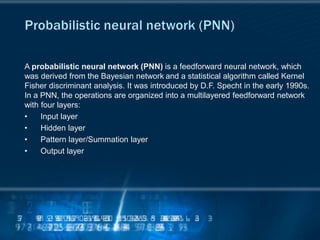The document discusses using a probabilistic neural network (PNN) to analyze seismic data and well logs to identify physical attributes, describing the layers and processing of the PNN model as well as examples of preprocessing seismic data and attributes to train the PNN to accurately predict properties like porosity and hydrocarbon volume. The PNN is trained on normalized seismic attribute data and well logs then applied to the full 3D seismic volume to generate property predictions across the area.




















